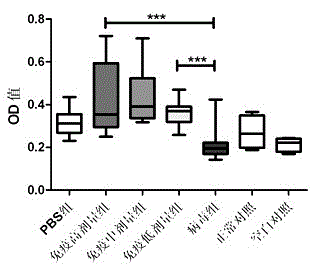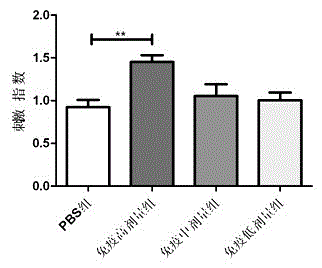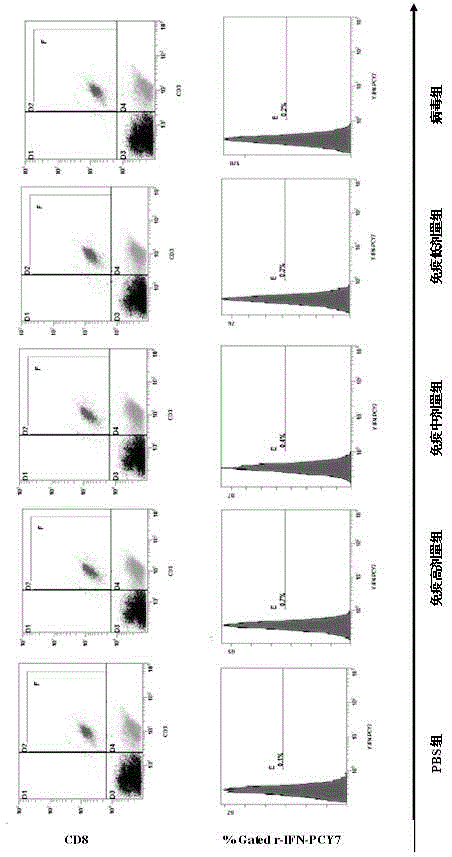Bivalent vaccine for hemorrhagic fever with renal syndrome and its preparation method
A technology for renal syndrome and hemorrhagic fever, applied in biochemical equipment and methods, microbe-based methods, microbes, etc., can solve the problem of underrepresentation of vaccine strains
- Summary
- Abstract
- Description
- Claims
- Application Information
AI Technical Summary
Problems solved by technology
Method used
Image
Examples
Embodiment 1
[0020] Embodiment 1 Obtaining and identification of Hantavirus (Hantavirus) HV004
[0021] 1. Virus collection and sequencing
[0022] (1) Rat lung tissue, mite vector suspension, and blood samples from HFRS patients were collected from the middle and lower reaches of the Yangtze River from 1985 to 2009.
[0023] (2) Indirect immunofluorescence (IFA), enzyme-linked immunosorbent assay (EILSA), (Reverse transcriptase- Polymerase chain reaction, RT-PCR) method detection, screening mouse, mite, human virus antigen positive samples. The RT-PCR screening process is as follows: use the virus-specific RNA extraction kit (Promega) to extract the total RNA of the sample; detect the RNA content with a nucleic acid analyzer, and the RNA OD260 / 280 of all samples is ≥ 1.9, and then take 50ng RNA for RT-PCR reaction; Random primers were used for reverse transcription, and the reaction conditions were 37°C for 60 minutes, 93°C for 5 minutes to stop the reaction, and then quickly cooled on ...
Embodiment 2
[0033] Example 2 Preparation of virus vaccine
[0034] 1. Preparation of monovalent vaccine
[0035] (1) Continuously pass HV004 through the brain tissue of BALB / C suckling mice for 8 generations, harvest the brains of the affected mice, grind them into a homogenate, add protamine sulfate (final concentration: 1mg / ml), and initially remove tissue DNA and exogenous DNA The content is not more than 10ng / dose.
[0036] (2) After centrifugation at 110,000 g for 2.5 hours in a sucrose density gradient zone, a bright band between 30% and 45% and between 45% and 60% was obtained to purify the virus particles. Virus titer was 6.5lgCCID50 / ml; bacteria test and mycoplasma test were negative, and the virus titer was 1:1024 by IFA method.
[0037] (3) Use 2% V / V HEPES 1mol / L pH7.5 and 0.14% W / V NaHCO3 to adjust the pH of the purified virus stock solution to 7.4 at 4°C, and add 10% W / V BPL dropwise to make the final concentration 1 / 4000. After 24 hours of inactivation, the inactivated...
Embodiment 3
[0047] Embodiment 3 Animal experiments
[0048] The following is a detailed description of the monovalent vaccine as an example:
[0049] 1. Vaccine safety experiment
[0050] (1) Experimental research on animal allergy
[0051] 10ml of the sample was taken, and three guinea pigs were subcutaneously inoculated with calf serum as a control, and the guinea pigs were selected between 250-350g. Each animal was inoculated with 1ml, and the second injection was performed one week later, and each guinea pig was sensitized with 1ml subcutaneously. After three weeks of sensitization, each guinea pig was intravenously injected with the same sample 0.5ml, and no allergic reaction was observed in guinea pigs.
[0052] (2) Abnormal toxicity test
[0053] For the abnormal toxicity test, two kinds of animal tests, Balb / C and guinea pig, should be carried out, and the test animals should reach the clean level. A mouse with a body weight of 18-22 g is selected, and a guinea pig is selected...
PUM
| Property | Measurement | Unit |
|---|---|---|
| weight | aaaaa | aaaaa |
Abstract
Description
Claims
Application Information
 Login to View More
Login to View More - R&D
- Intellectual Property
- Life Sciences
- Materials
- Tech Scout
- Unparalleled Data Quality
- Higher Quality Content
- 60% Fewer Hallucinations
Browse by: Latest US Patents, China's latest patents, Technical Efficacy Thesaurus, Application Domain, Technology Topic, Popular Technical Reports.
© 2025 PatSnap. All rights reserved.Legal|Privacy policy|Modern Slavery Act Transparency Statement|Sitemap|About US| Contact US: help@patsnap.com



